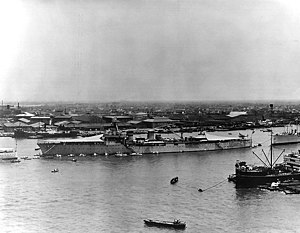Duguay-Trouin-class cruiser

Lamotte-Picquet at Shanghai, 1939
|
|
| Class overview | |
|---|---|
| Name: | Duguay-Trouin class |
| Operators: |
|
| Succeeded by: | Jeanne d'Arc |
| Built: | 1922-1927 |
| In service: | 1926-1952 |
| In commission: | 1926-1952 |
| Completed: | 3 |
| Lost: | 2 |
| Retired: | 1 |
| General characteristics | |
| Type: | Light cruiser |
| Displacement: |
|
| Length: | 181.30 m (594.8 ft) overall |
| Beam: | 17.50 m (57.4 ft) |
| Draught: | 5.2 metres (17 ft) |
| Propulsion: | 4-shaft Parsons single-reduction geared turbines; 8 Guyot boilers; 100,000 shp (75,000 kW) |
| Speed: | 30 knots (56 km/h; 35 mph) |
| Range: | 3,000 nautical miles (5,600 km; 3,500 mi) at 15 knots (28 km/h; 17 mph) |
| Complement: | 27 officers, 551 sailors |
| Armament: |
|
| Armour: |
|
| Aircraft carried: |
|
| Notes: | |
The three Duguay-Trouin-class light cruisers were the first major French warships built after World War I. They were excellent steamers and proved successful and seaworthy over a quarter century of service. All three achieved 33 knots (61 km/h; 38 mph) on trials and could easily maintain 30 knots (56 km/h; 35 mph) in service. Twenty-year-old Duguay-Trouin could still maintain 27.7 knots (51.3 km/h; 31.9 mph) at her post-war displacement of 10,900 tons. They were fast and economical, although with a limited range. The fate of these three ships after the French surrender illustrates the dichotomy within the French armed forces at the time: one ship was interned, then joined the Free French, another twice resisted Allied bombardment and was destroyed, and the third was disarmed at a French colonial port and subsequently sunk.
The design of this class was the result of a protracted process that had started in mid-1919, with the Italians as likely adversaries. A detailed design (Project 171) had been completed by the end of 1919, but there were significant reservations within the Navy and the Chief of the General Staff withdrew them in February 1920. While discussion continued, there were opportunities to compare with newly commissioned cruisers of other navies. The foreign designs were indeed superior, particularly armament.
At the end of 1920, after having examined copies of the plans for the U.S. Omaha class, four designs had been drafted. All four used hulls based on the Omahas, with eight newly designed 155 mm (6.1 in) and four 75 mm (3 in) anti-aircraft guns and twelve torpedo tubes. The differences lay in the combinations of power and protection.
Design C was selected and detailed work started. The new class would achieve 34 knots (63 km/h; 39 mph), using oil firing and single-reduction geared turbines. The main armament would be a new breech-loading M1920 gun of 155 mm calibre with a range of 26,100 metres (28,500 yd). The calibre was selected to use the same 155 mm shells manufactured for the Army. In action, this weapon proved to be slow to operate. The 75 mm anti-aircraft battery was of the M1922 type.
The ships were lightly armored with barely splinter-proof gun shields, but extensive watertight subdivision included sixteen transverse bulkheads, with a double hull around the engineering spaces. Orders were placed during 1922 on this basis, despite determined efforts to "improve" the design. After completion, single catapults were installed on the quarter-decks of each ship, initially with two Gourdou-Leseurre GL-812 HY flying-boats, later the GL-832. Duguay-Trouin and Primauguet were subsequently equipped with a single Loire 130 in the 1930s.
...
Wikipedia
